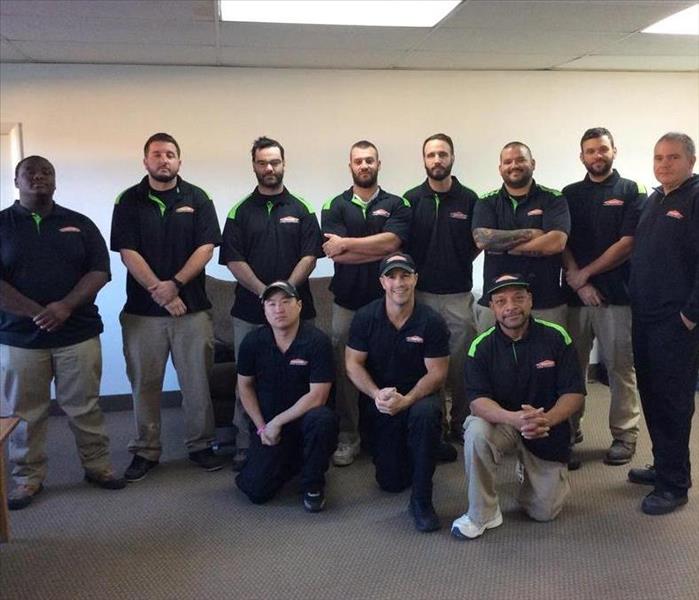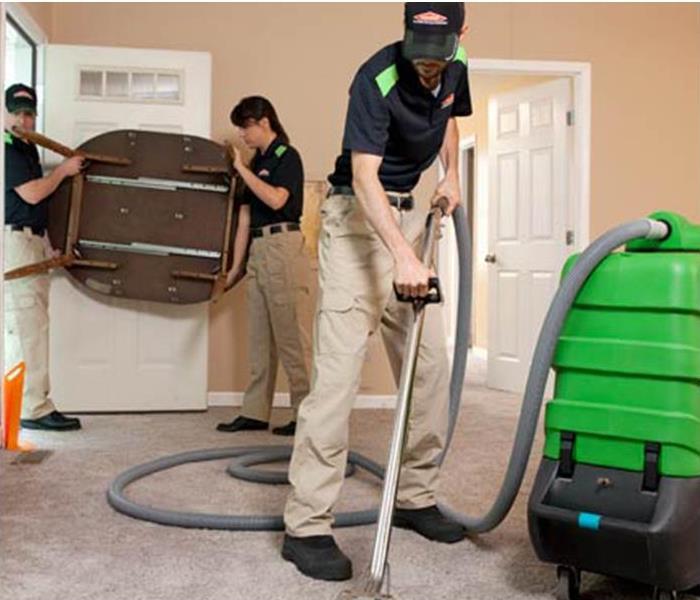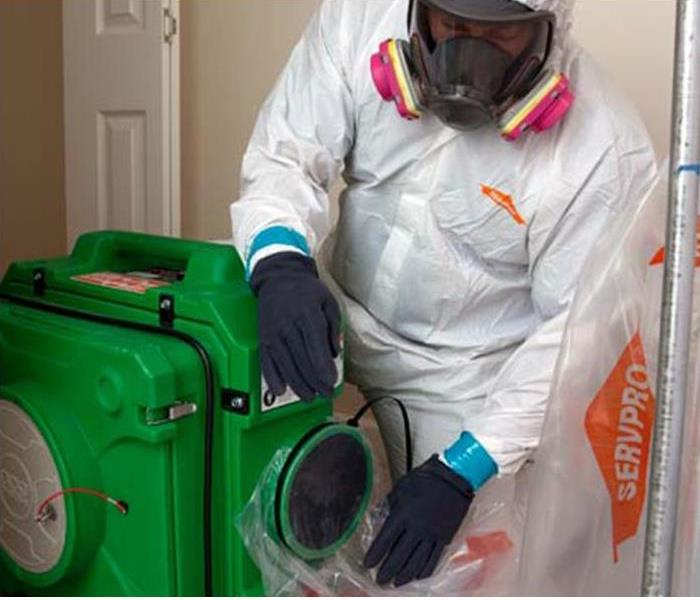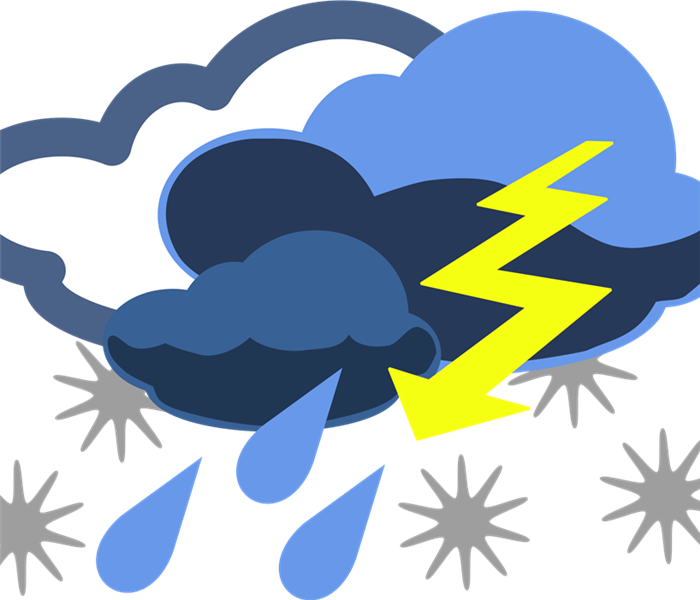Recent General Posts
Most Common Types of Homeowners Claims
4/17/2018 (Permalink)
Did you know that in 2016 losses due to natural disasters in the U.S. totaled $23.8 Billion in costs. Severe thunderstorms accounted for 60% of the losses at $14 Billion.
The most common types of homeowners insurance claims policy holders will file are:
1. Theft- Unlike most of the other types of losses this one can be prevented with security measures like an alarm system, safe box or my personal favorite a dog!
2. Wind Damage- Be sure to check trees and shrubs around your property to make sure they will not cause damage to your home. Also checking the shingles on your roof should be done yearly.
3. Water Damage (non-weather related)- This list includes causes like a pipe burst, leaky appliance, sump pump failure or even a sewer back up.
4. Water Damage (weather related)- This is most common in the Northeast where colder temperatures are common. Some measures can be taken to avoid instances like clearing out snow and ice to prevent buildup.
5. Hail Damage- This type is most common in the West and Midwest where golf ball sized hail can cause serious damage to property.
Emergency Ready Profile
2/21/2018 (Permalink)
 Our professionally trained crews are ALWAYS ready
Our professionally trained crews are ALWAYS ready
The Best Way to Reduce Business Interruption Following a Disaster is to Plan For it NOW.
As many as 50% of businesses may never recover following a disaster, according to the latest industry research. Of the businesses that survive, the overwhelming majority of them had a preparedness plan in place. Pre-planning can serve as an insurance policy aimed at peace of mind.
*** This a NO COST assessment of your facility ***
Important contact and phone numbers as well as insurance information, contractor, plumber, electrician and roofer info and more at your fingertips no matter where you are. If you are stuck at home and circumstances don't allow you to get to your business, you have everything you need right there with you. SERVPRO of Northeast Bergen County can help you coordinate at a time when you need help the most.
A concise Profile Document that contains only the critical information needed in the event of an emergency.
It will only take a little time to complete and will not take you away from your current projects.
The SERVPRO Emergency Ready Profile (ERP) could be a valuable tool to help restore your business in the shortest amount of time possible.
To set up this free service, call Tony D'Arco @ SERVPRO of Northeast Bergen County, CALL NOW or contact Tony via e-mail: TDarco@SERVPROparamus.com
What are The Common Causes Of an Ugly Ceiling Stain?
1/23/2018 (Permalink)
 Residential Restoration Cleaning
Residential Restoration Cleaning
Nothing can be more annoying than finding an ugly looking water stain on your ceiling every time you look up. If you are like most home owners, this ceiling stain will keep on bugging you until fixed. The first step in this direction should be to find the source. However, finding the real culprit can be difficult, inspecting the surrounding areas of the ceiling stain can be a good place to start with. Identifying the cause can also determine whether it can be solved with a DIY project or a residential restoration cleaning company would be required.
If you see that the damage has reached a larger area, don’t delay in calling a professional restoration company. Whether you need to call a local plumber or a roofing company, do so immediately.
What are the common causes of ceiling water damage?
Pipe leak - The most common reason for a water damage is a leaking pipe running under floors and behind walls. When you’re trying to identify what caused the ceiling stain, check the roof, the floor above and even the floorboards. If you hear the sound of running water, then you can guess that the reason is a leaking pipe. Keep in mind that a leaky pipe or fixture can leak onto a board at one spot and run along the board for a surprisingly long distance before the water drops onto the ceiling tiles below. The leak might not be directly above the spotting in the ceiling.
Roof problems – Missing shingles or loose parts in the roof can cause the water from rain or snowfall to enter into your house. Roof problems can also include cogged ice dams during winters. A long term fix for this is to upgrade the insulation in your attic.
Worn out pipes- The plumbing system in older homes may be outdated and develop leaks more easily than others. In other cases, pipes can also “sweat” water which means that older, worn out or improperly installed pipes are causing water to drip from the pipes.
Removing the ceiling water stain
While some stains can easily be removed with a stain-killing primer and a fresh paint, others will require the professional skills of a residential restoration cleaning company. It may also require replacing a large part of your ceiling. If not, the problem will keep occurring.
The ceiling stain will be completely removed only after the source has been eliminated, otherwise you’ll find yourself in the same situation. Once the source has been dealt with, the ceiling will require a structural repair. Whether you decide to call a professional house cleaning company or conduct a DIY project, ensure that the problem is fixed thoroughly.
Preventing future ceiling stains
Addressing ceiling stains is not a task you’ll enjoy tremendously, but delaying it will only bring you bigger problems down the road. The longer the damage is left to sit on the ceiling, the damage will continue to grow and become a serious problem requiring major structural changes.
Once the stain has been repaired, you can prevent it from happening again by keeping the moisture levels low. This also prevents mould growth and bacterial infestations. Also have a professional roofing contractor perform an inspection to ensure that it’s in good condition and not at risk for any leaks.
Sewage cleanup – why you should depend on professionals to do it right
12/20/2017 (Permalink)
 sewage removal services
sewage removal services
Even a minor plumbing problem can cause serious menace around the house and force the homeowners to treat the problem themselves with a mop, bucket and perhaps some bleach. Such minor water cleanup problems can be solved without professional help, but when it comes to sewage backup, it cannot be solved with a simple DIY project.
Sewage water is toxic. Sewage backup contains harmful bacteria and other dangerous elements that pose serious health risks to anyone exposed to it. Many a times, homeowners believe that treating problems such as a pipe burst or standing waste water lies within their capabilities, the truth however, is that water cleanupshould be best left to professionals to ensure safety and best outcomes.
Read on to know more about this dangerous sewage backups and why you should let professionals take care of it.
Why Sewage backups are dangerous?
Most sewage backup occurs when the lateral line between your home and the main sewage line gets blocked. The most common reasons for this are old worn out pipes, tree roots, and rain water that causes soil to shifty and block the lateral line. When standing sewage gets accumulated, you are exposed to morbid viruses, bacteria, fungi and deadly parasites. There have been cases where people have been affected by diseases like Hepatitis A and Encephalitis due to exposure to toxic sewage backups. Hence, it is important to address the problem as early as possible and call for professional sewage removal services.
Why should you let the professionals do it?
- Professionals follow a strict protocol
Proper sewage cleanup involves interrelated procedures which the professionals are trained to undertake. Raw sewage and the clogs which originate from deep within the plumbing can damage the structure of your house permanently. Unorganized and amateur attempts can magnify the problems. The professional companies providing specialized sewage removal services operate according to strict standards, minimizing further damages, and unclog pipes and prevent it from happening again.
- Professionals use special equipment
Professionals make use of special equipment including commercial grade vacuums and pumps to safely remove contaminated water. These hi-tech machinery is available only with professional companies and require professional handling for which their technicians are trained.
- Professionals discard contaminated property
Items such a furniture or carpets, that may have come in contact with sewage water and pose health risks, should be identified and discarded. Your cleaning crew will have the expertise to identify the items which are salvageable and the ones which must be removed.
- Professionals will sanitize your house
The cleaning job should be followed by sanitizing the entire house to completely get rid of the lingering microbes. Sanitization is also important to prevent mold growth, which causes its own host of health problems. Also, there are several infected areas in the house which can only be accessed by experts. By using the right cleaning methods and agents, the professionals will clean the crevasses, ducts and other difficult-to-access-areas, leaving your house fully sanitized and safe to occupy.
What can you do until professionals arrive at your doorstep?
It is recommended that all the members stay away from the sewage accumulation. However, until help arrives, owners can take small steps to ensure safety. These can include – turning off the electricity, shutting down the water lines, and avoiding the use of AC’s or heaters to prevent the circulation of contaminated dust around the house.






 24/7 Emergency Service
24/7 Emergency Service


